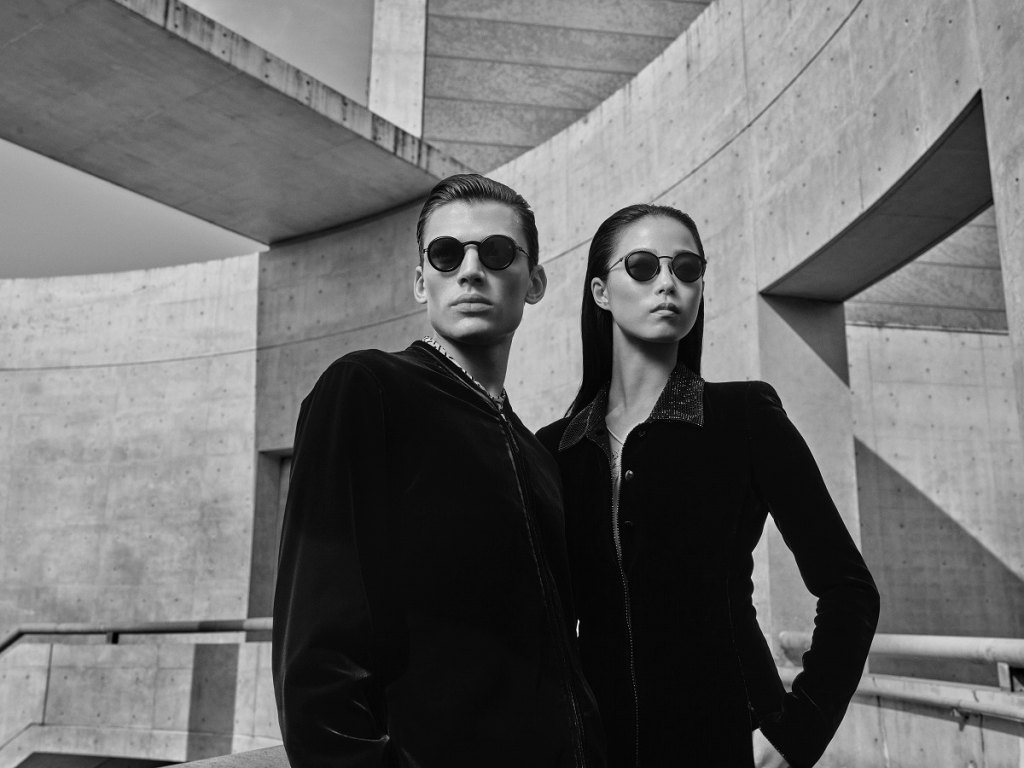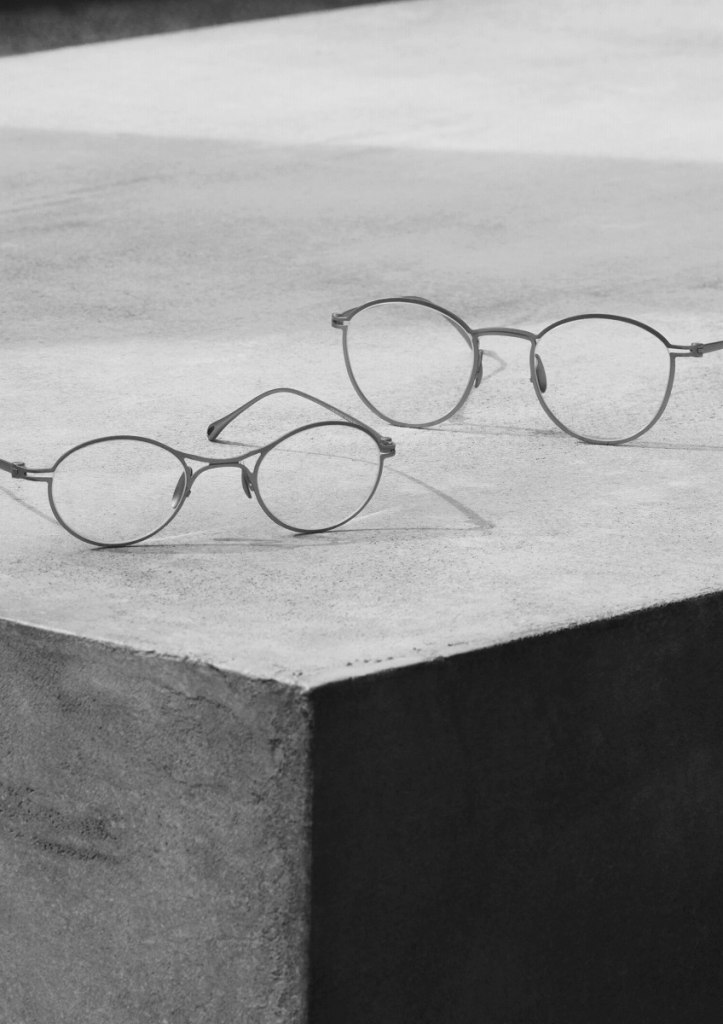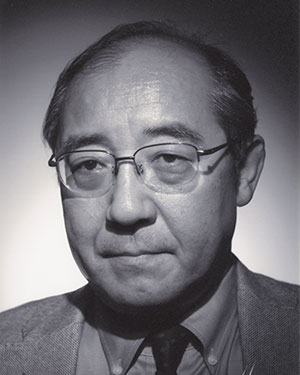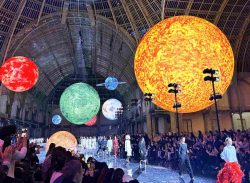
Models wearing sunglasses from the collection by Giorgio Armani and Yuichi Toyama. brands
12:00 JST, February 3, 2024
The year 2024 started with the Noto Peninsula Earthquake on New Year’s Day, a catastrophic disaster that devastated the Hokuriku region (Ishikawa, Fukui and Toyama prefectures).
For the fashion and apparel industries, this region is a major production area of filament yarns for synthetic fabrics such as polyester and nylon. Nylon produced in the region is used in a wide range of products, from Prada’s famous nylon bags to low-priced clothing. Fortunately, most of the factories escaped the worst of the disaster, and impact has been limited to delivery delays.
Sabae, Fukui Prefecture, was also left mostly unscathed because it was relatively distant from the epicenter. The city, nicknamed “eyeglasses town,” is often cited as a successful example of regional revitalization in Japan. Toward the end of the Meiji era (1868-1912), Gozaemon Masunaga, regarded as the father of Japanese eyewear, helped eyeglass manufacturing take root as a side job for farmers in Sabae during the agricultural off-season.
Production of titanium eyeglass frames in the 1980s gave a big boost to Sabae, and the city became one of the world’s major eyewear production areas, along with Belluno, Italy; Jura department in France; and Shenzhen, Dongguan, Wenzhou, Danyang and Xiamen in China. Sabae has had hard times as well, due to low-priced glasses shops, but the city continues to provide top-quality spectacles to the world. In 2003, THE291 (pronounced “The Fukui”) brand was established in Sabae as the city’s unified brand. A whopping 95% of domestic glasses are produced in and around Sabae. And did you know that some of the fashionable sunglasses worn by the cast of the “Matrix” film series were manufactured in the city?
In March 2018, EssilorLuxottica, the world’s largest eyewear maker, made headlines when the company bought out 67% of the shares of Fukui Megane Industry Ltd. in Sabae, making the company EssilorLuxottica’s production center in Japan.
Late last year, Sabae was in the news again. Giorgio Armani, the foremost men’s fashion brand in the world, and Yuichi Toyama., the namesake brand of Japan’s top eyewear designer Yuichi Toyama, collaborated on eyewear that went on sale from late November at some Giorgio Armani boutiques in the country, stores selling Yuichi Toyama.-brand eyeglasses and other places.
Toyama was born in Tokyo in 1971. He was employed by an eyewear maker in Fukui Prefecture in 1993 and worked in marketing, planning and development. He went independent in 2004 and launched his own brand, USH, in 2009, which he rebranded as “Yuichi Toyama.” from the spring-summer collection in 2017. Now 52, he is famous as one of Japan’s top eyewear designers, and his brand is so popular that it’s a challenge to even purchase its products.
“I happened across [Giorgio] Armani’s eyewear designs in the latter half of the 1980s, and that’s what made me decide to become an eyewear designer,” Toyama said.

Eyeglasses from the Giorgio Armani and Yuichi Toyama. collection
As someone who is familiar with fashion in the 1970s and the 1980s, I find his words impressive. Giorgio Armani successfully made Italian tailored suits a world standard as a men’s fashion revolutionary in the late 1970s, but it was the sunglasses that ultimately nailed down his styling.
Now, let me run off on a tangent and mention Giorgio Armani will turn 90 this year. I wonder what’s in store for him in 2024. I’m also setting my eyes on another iconic, active elder in the fashion world, Ralph Lauren, who is five years younger.
The Giorgio Armani-Yuichi Toyama collaboration has recently born fruit in the form of a unisex eyewear collection that is both elegant and timeless, manufactured with a fusion of Armani’s Italian style, traditional Japanese craftsmanship and Toyama’s innovative designs. There are four types of eyewear, two each of spectacles and sunglasses, all complete with Toyama’s signature “Double Dutch” frames inspired by jump ropes. Each type is priced at about ¥100,000.
Of the two eyeglass types, one has a minimalist design with a titanium frame, and the other comes with oval lenses in a 1980s-style silhouette. Both types offer a choice of four colors and will have a ¥99,000 price tag. As for the sunglasses, one type has smooth, round rims made of beta titanium alloy and acetate. The other fuses a Giorgio Armani eyewear style from the 1980s and Yuichi Toyama’s Double Dutch frames. The sunglasses, both priced at ¥103,400, will also have the option of four different colors.
Japanese-made titanium of the finest quality is used for the rims, and the hinges are engraved with the logos of both brands. Of course, the glasses were all manufactured in Fukui Prefecture.
On a side note, the promotional photos for the collaboration were shot at the Osaka Prefectural Sayamaike Museum, which was designed by architect Tadao Ando, who also designed the Armani/Teatro in Milan and is a good friend of Armani himself.

Akira Miura
Miura is a journalist and a former editor in chief of WWD JAPAN.
"Culture" POPULAR ARTICLE
-

Van Cleef & Arpels Dazzles with Art Deco Artisanry at Tokyo Exhibit
-

Disney’s ‘Twisted-Wonderland’ Animated Series Puts Villains in Spotlight: New Show Features School Inspired by Classic Disney Films
-

Ayumi Hamasaki’s Shanghai Concert Canceled Day Before Schedule as Part of Beijing Backlash
-

‘The World Masterpiece Theater Series’ Celebrates 50 Years; Animator Looks Back on Creating Anime Classics
-

Popularity of Piggy Banks Across Time and Place Seen at Bank’s Museum of Money Boxes in Hyogo Pref.
JN ACCESS RANKING
-

Tokyo Economic Security Forum to Hold Inaugural Meeting Amid Tense Global Environment
-

Keidanren Chairman Yoshinobu Tsutsui Visits Kashiwazaki-Kariwa Nuclear Power Plant; Inspects New Emergency Safety System
-

Imports of Rare Earths from China Facing Delays, May Be Caused by Deterioration of Japan-China Relations
-

University of Tokyo Professor Discusses Japanese Economic Security in Interview Ahead of Forum
-

Japan Pulls out of Vietnam Nuclear Project, Complicating Hanoi’s Power Plans


























